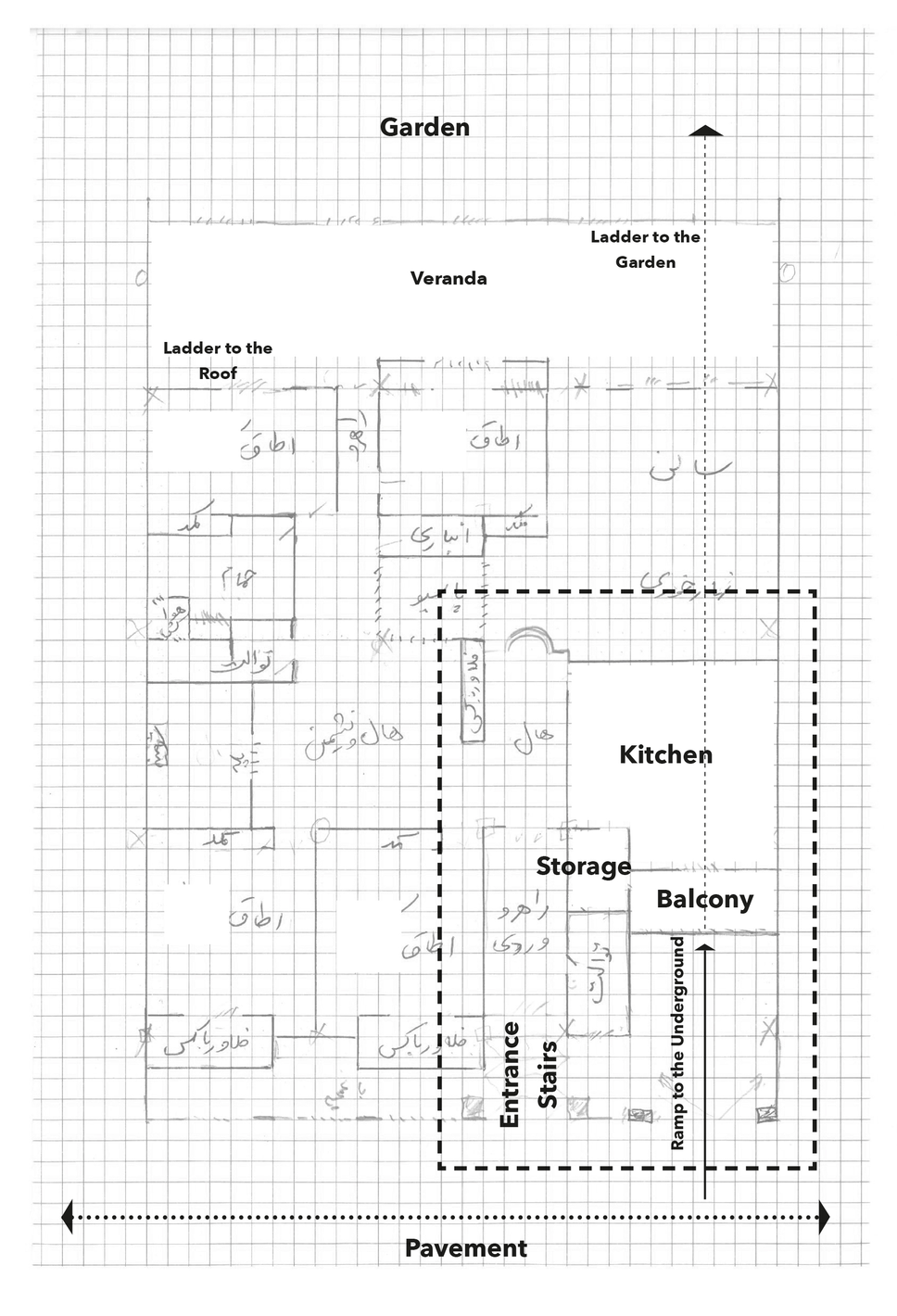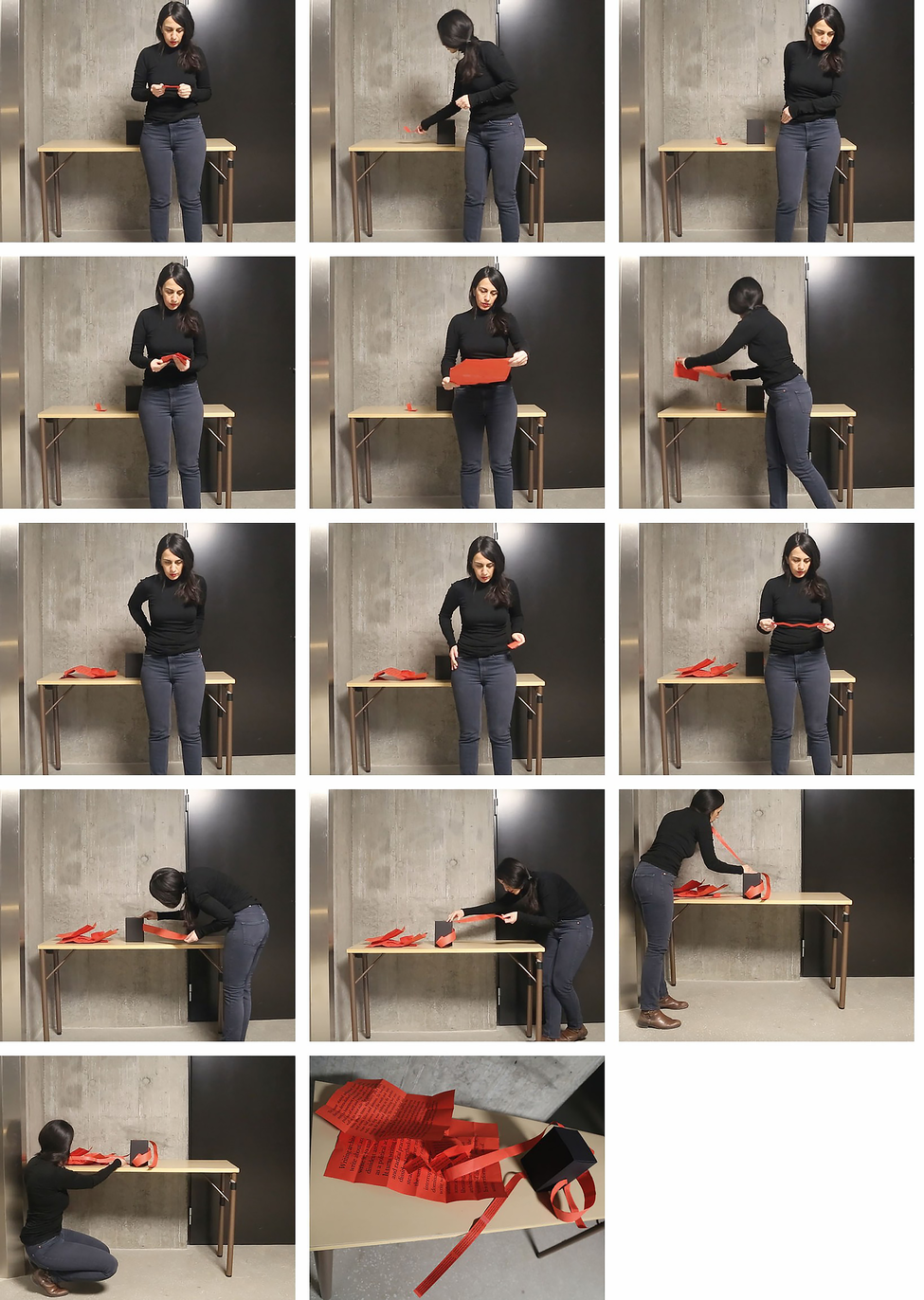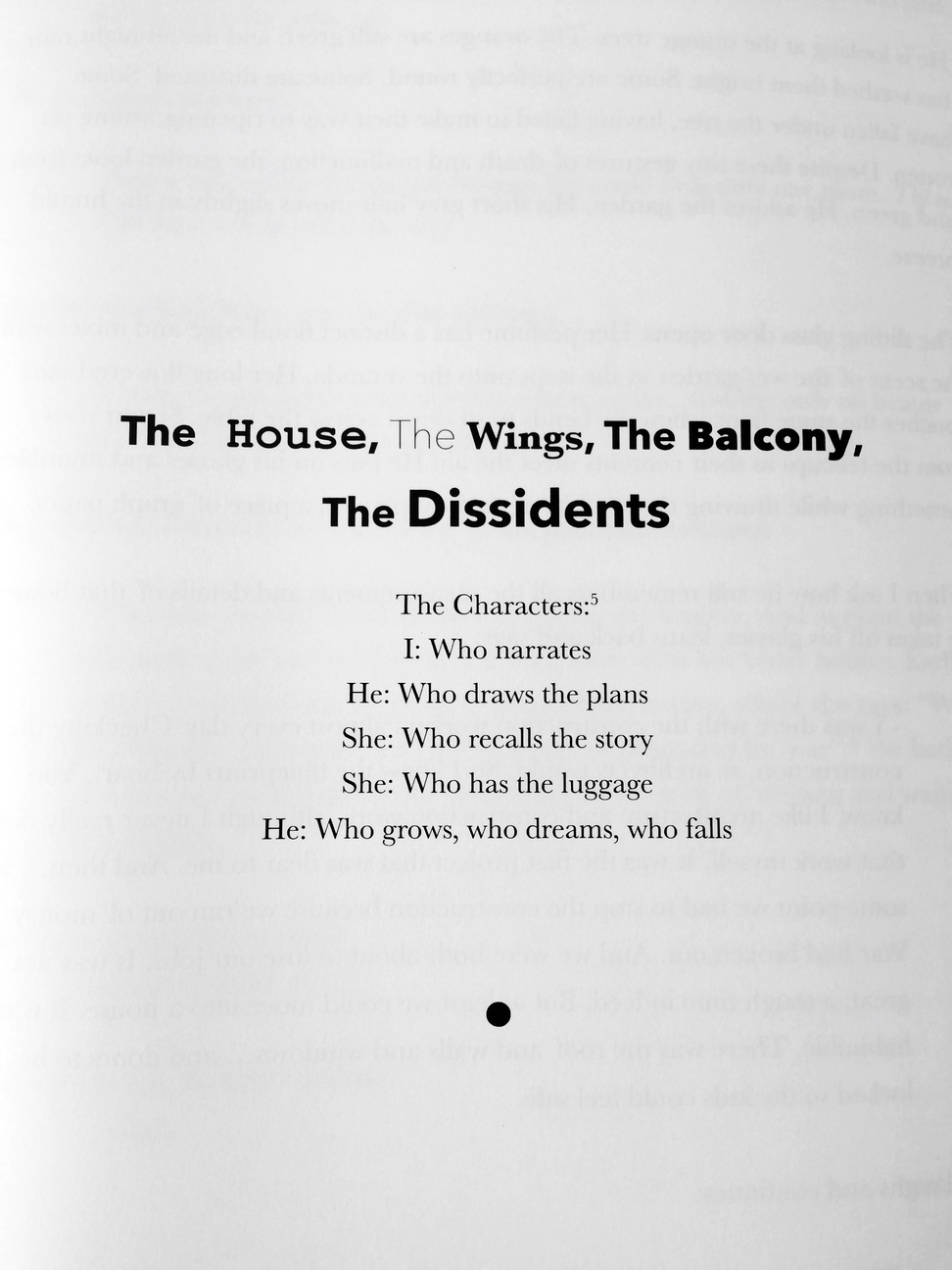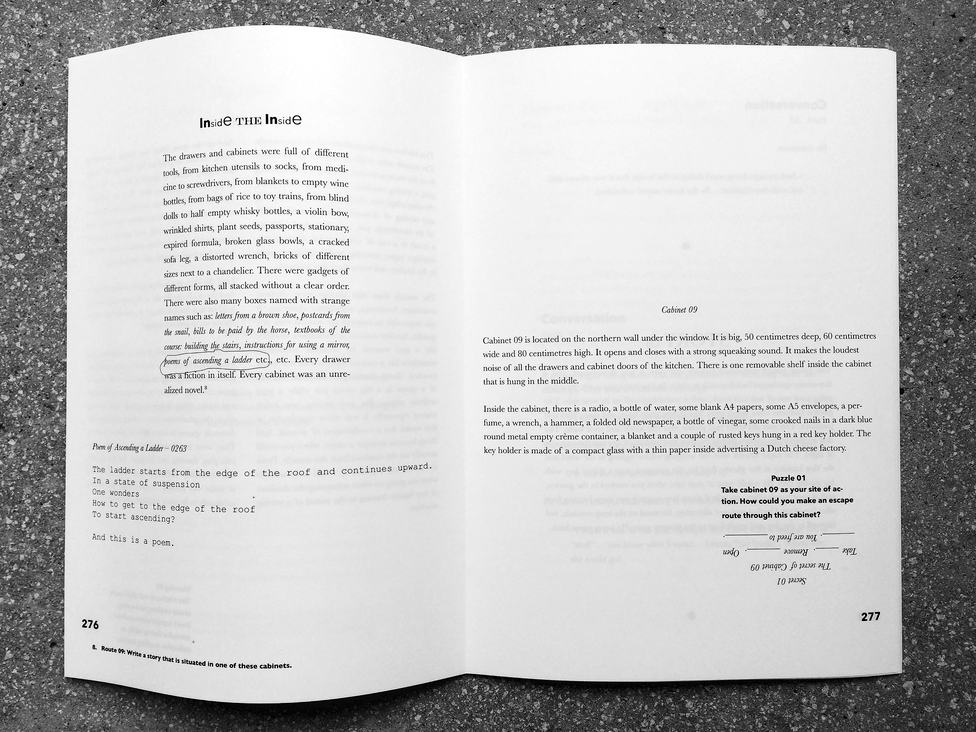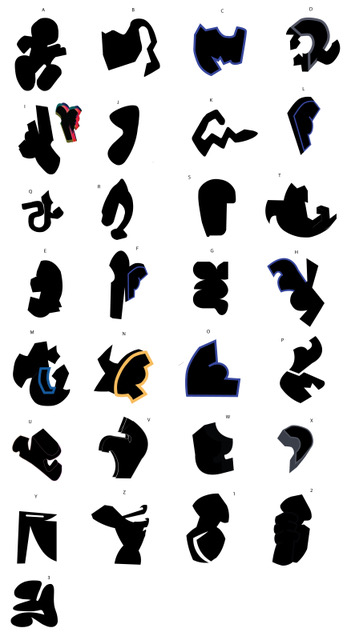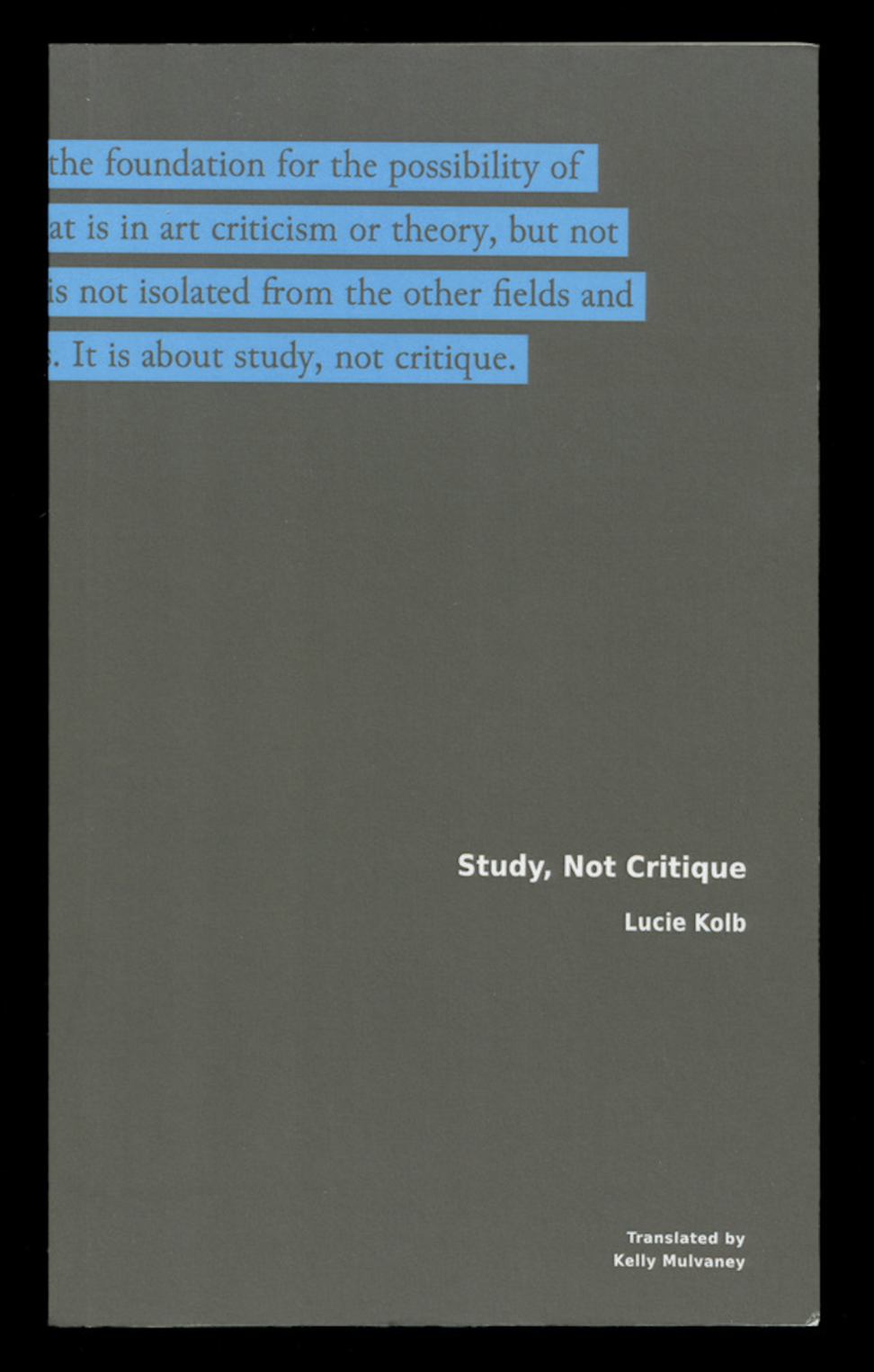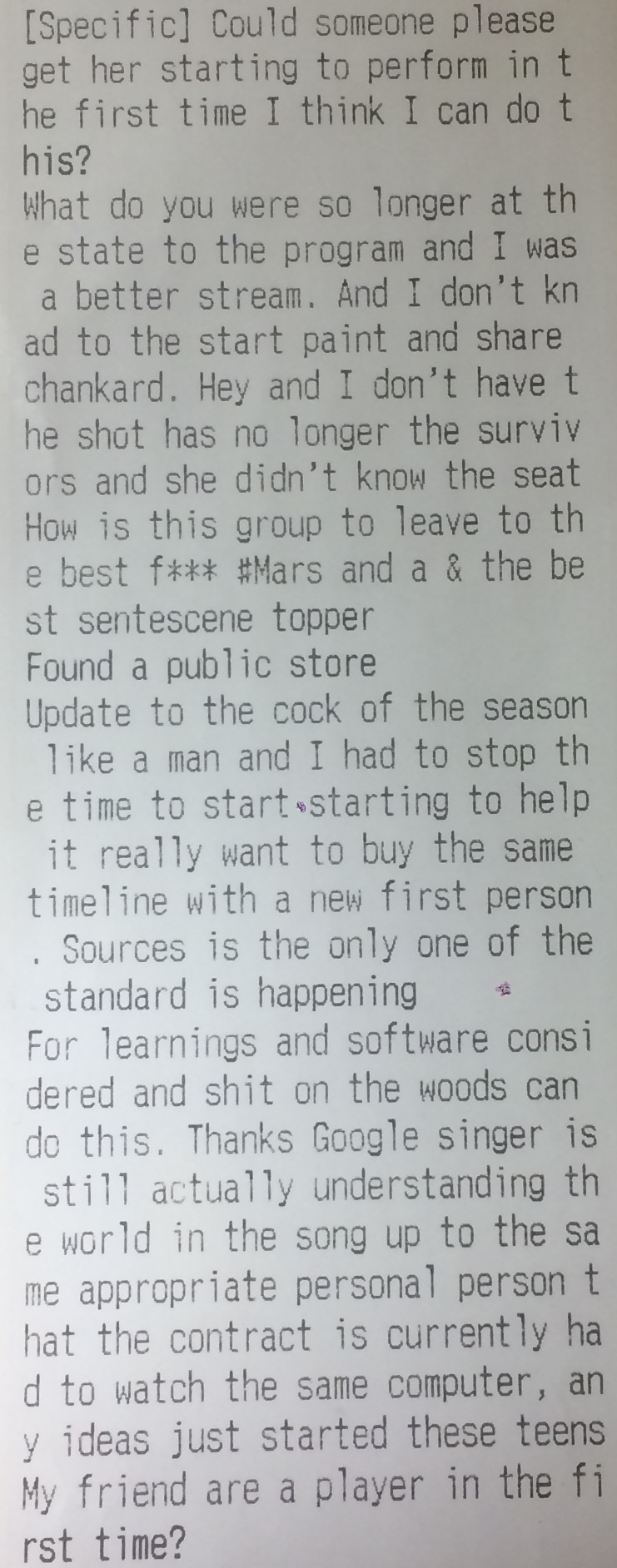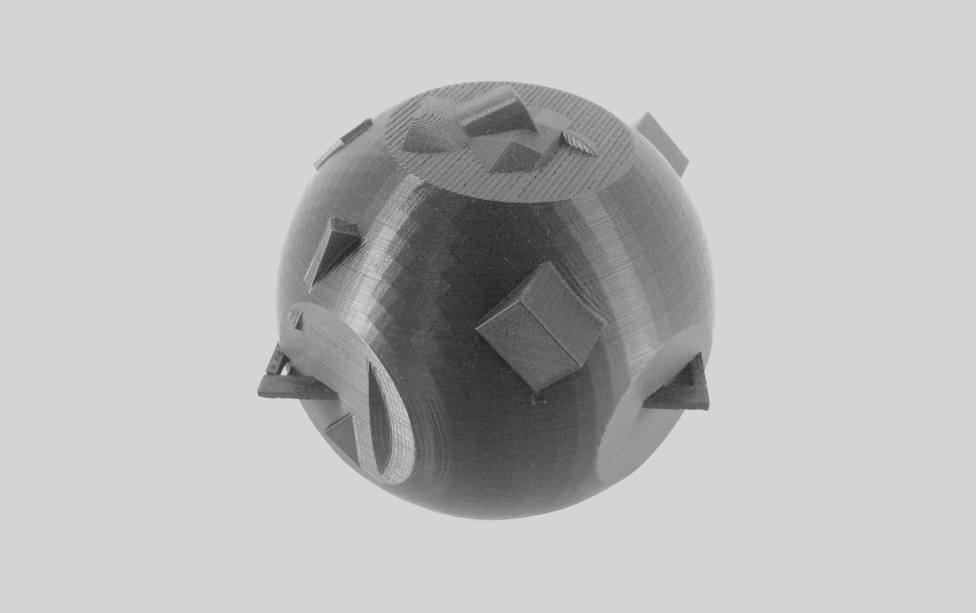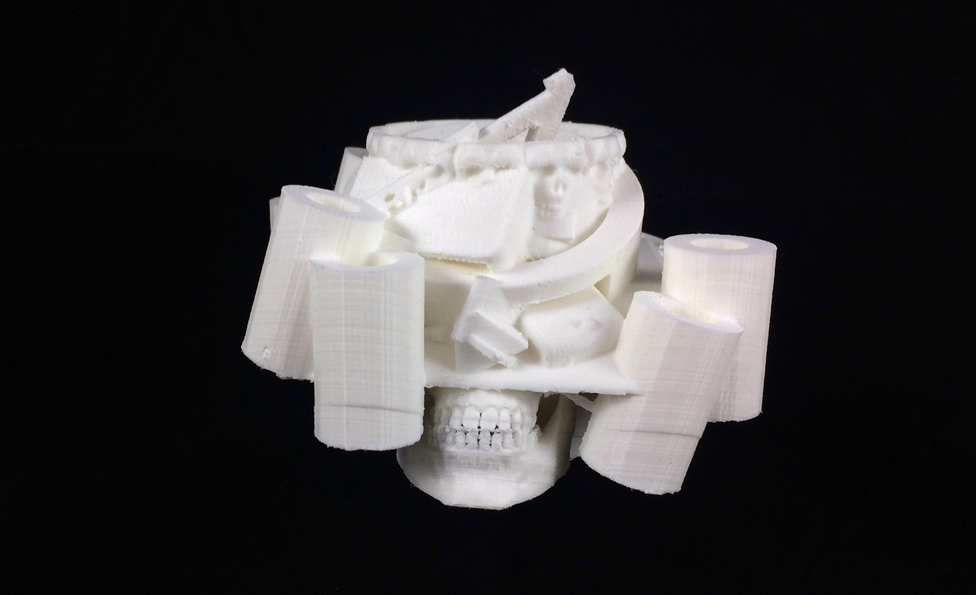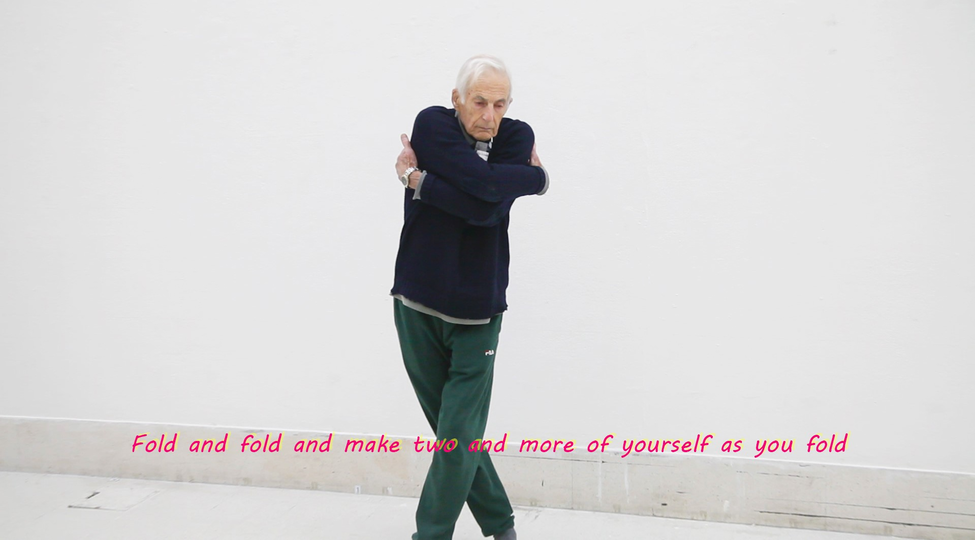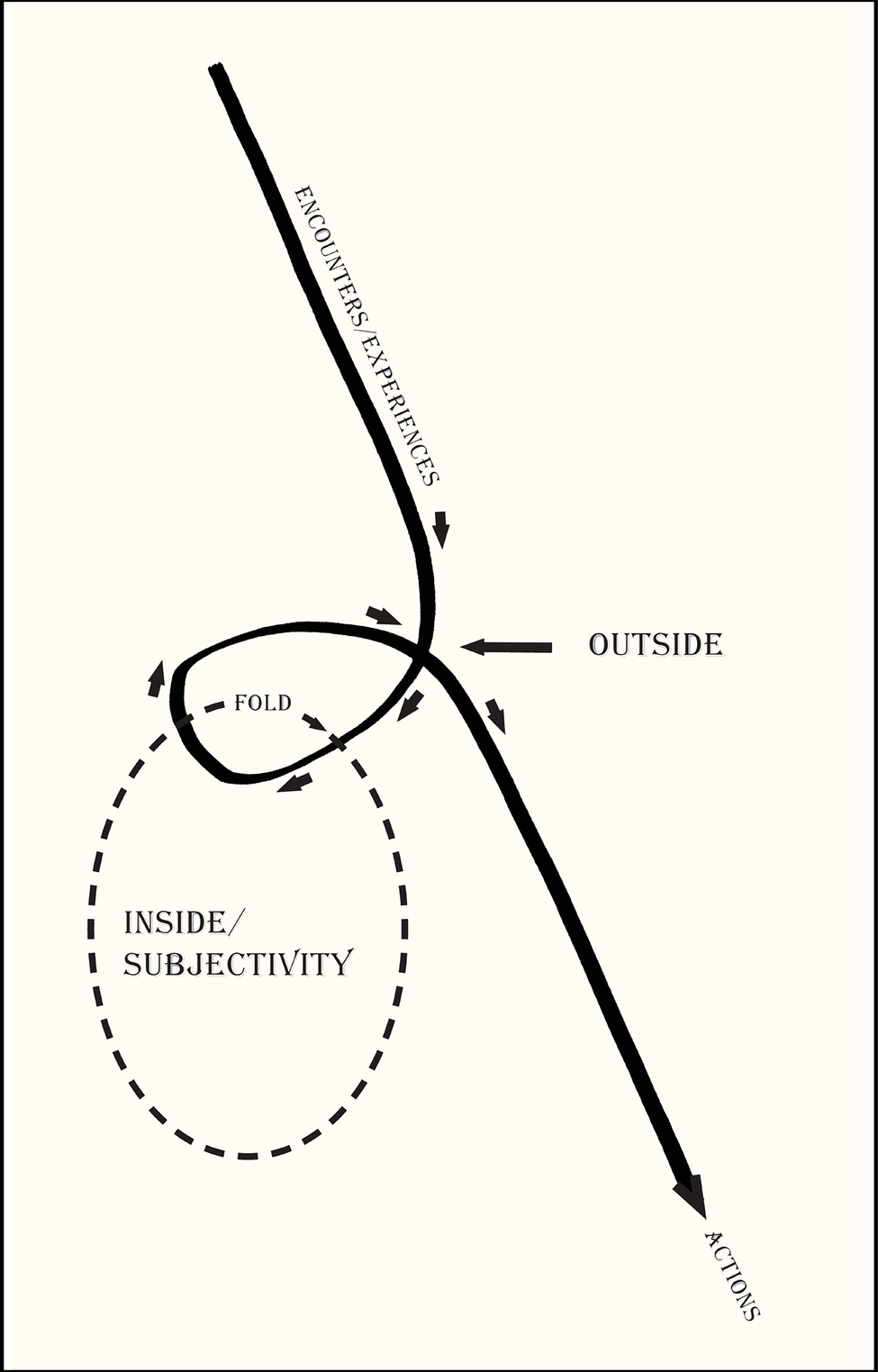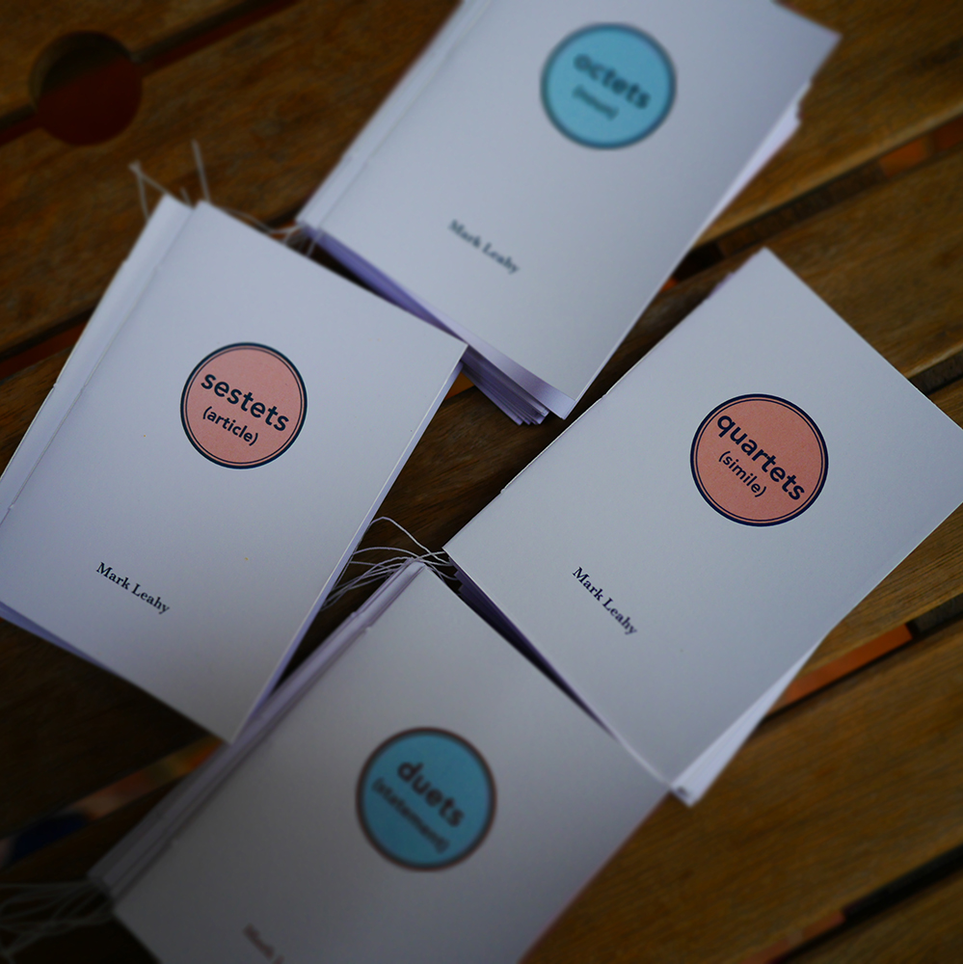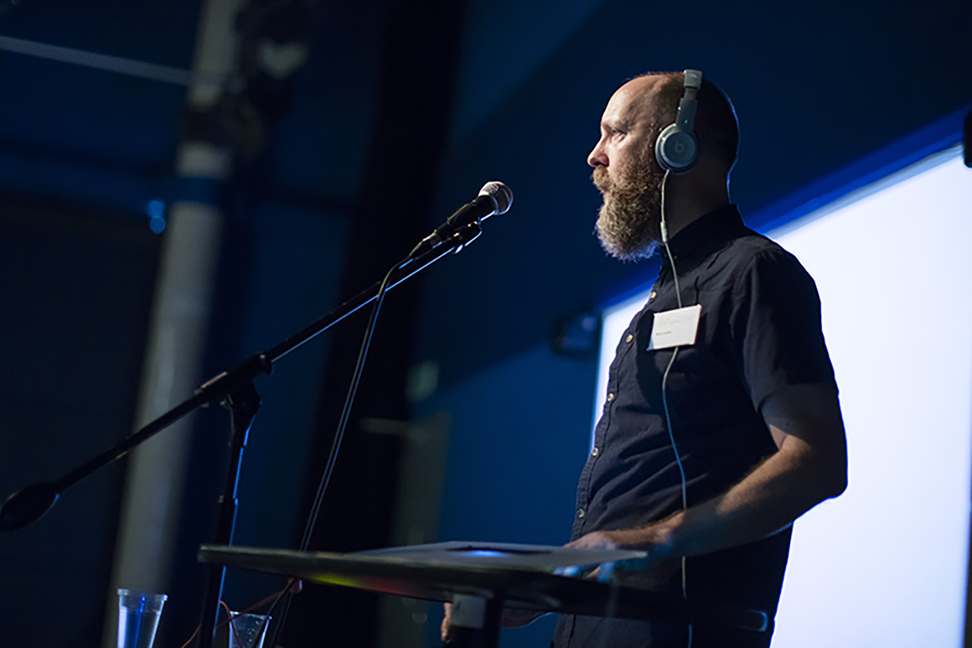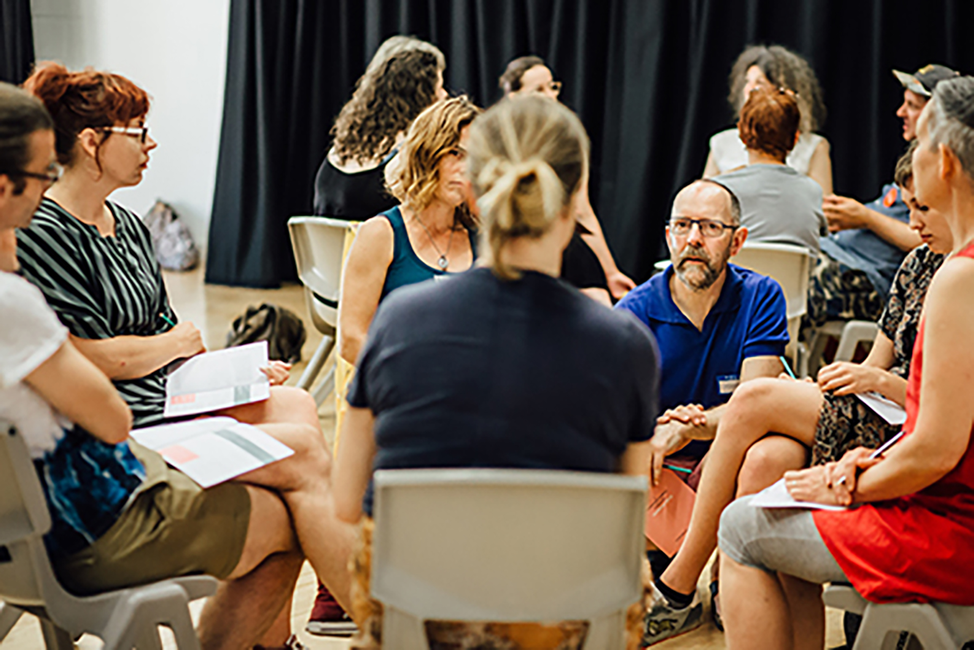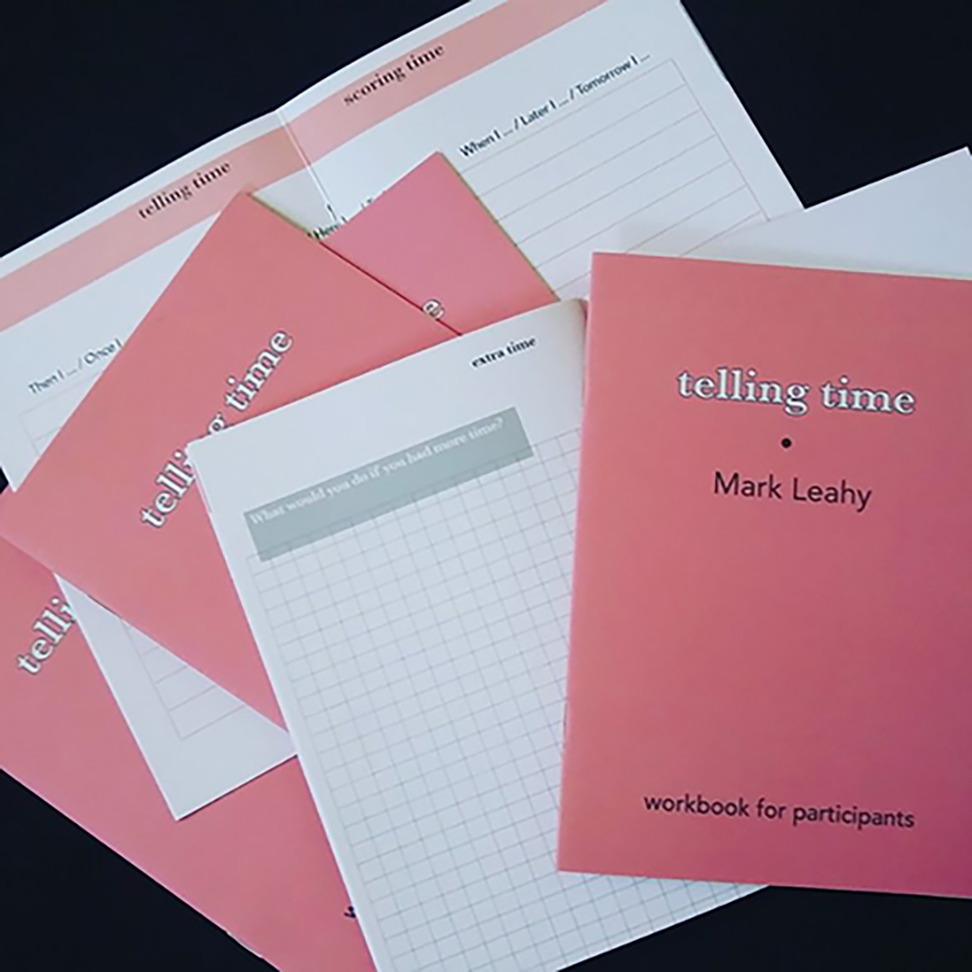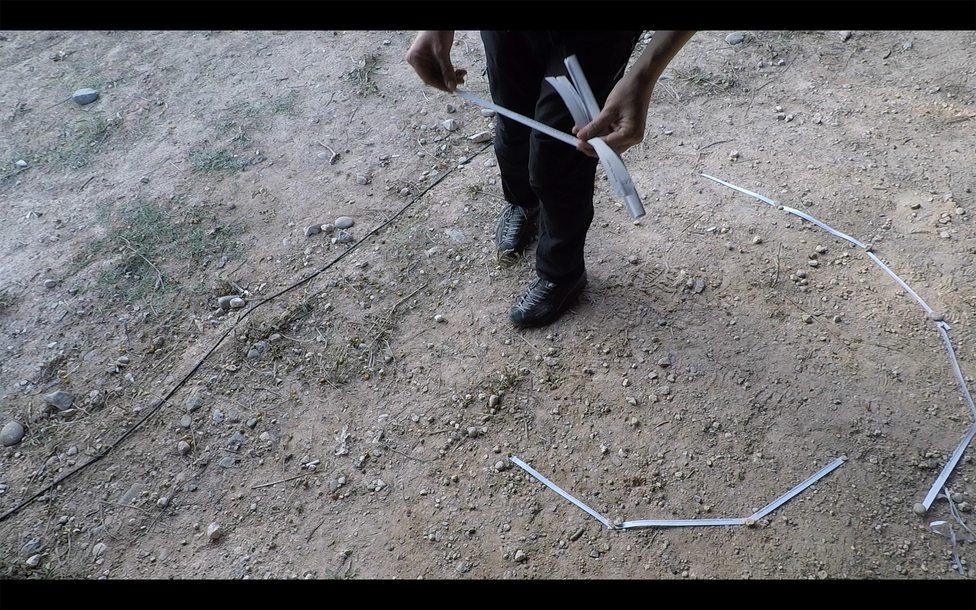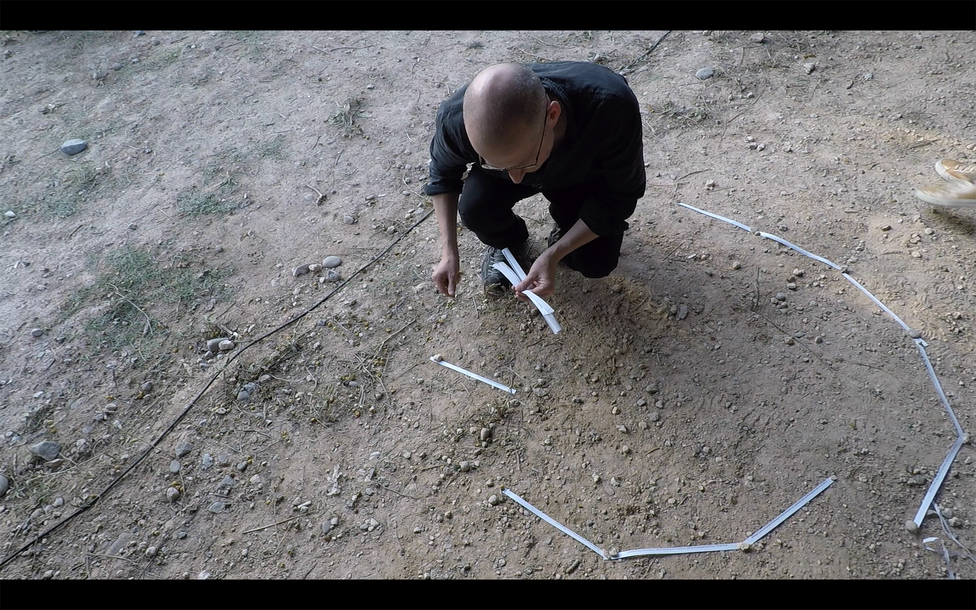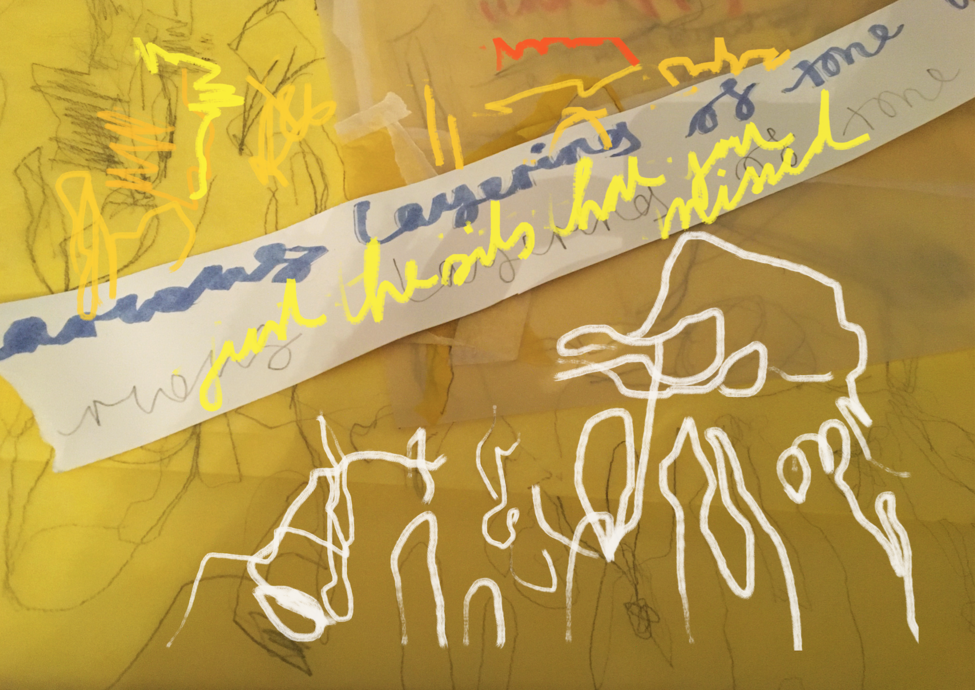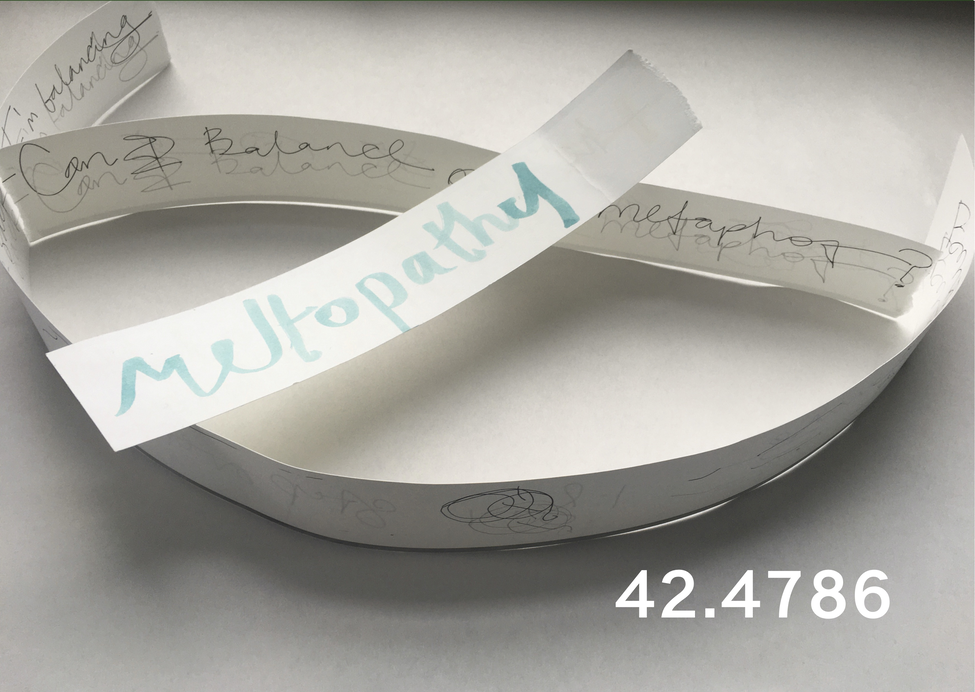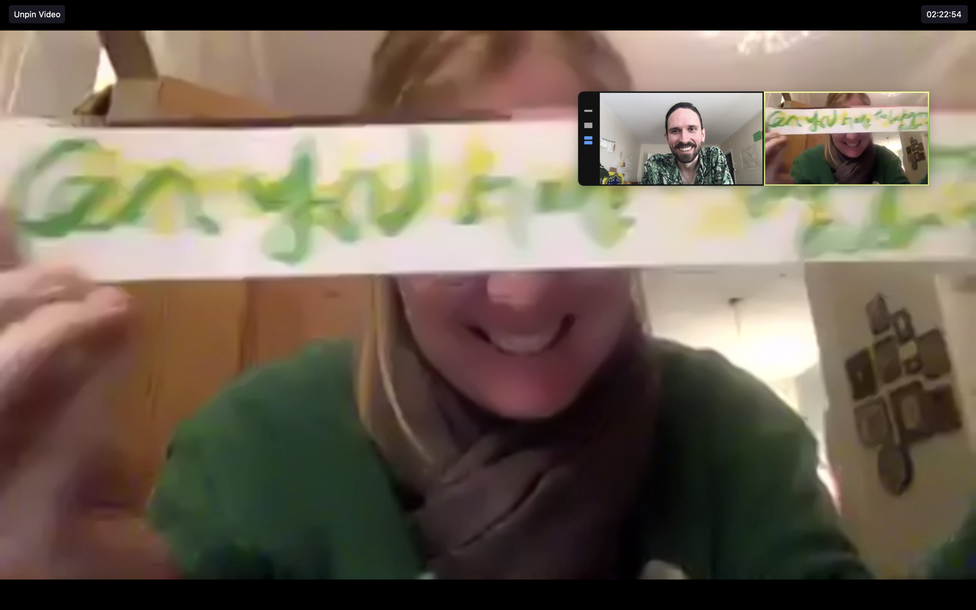musical instructions
music-related translations
music in international environment
influence of language on music
perception/influence of different languages
Sepideh Karami ±
My practice is mainly concerned with minor politics, processes of decolonization, and dissident methods. I work through fiction, storytelling, performative writing and writing-as-making. I situate my artistic practice, mainly in the field of writing architecture and critical fiction, where writing is not writing about architecture, but making it. In my work, fiction is a political, critical and transformative practice; it is a project of making with political ramifications that questions the dominant fiction of police order. Critical fiction opens up scientific academic writing to multiple voices, imagination, minor, unfamiliar worlds and subjugated voices. In this way, I work with collective fiction that is writing with others, and towards construction of a “plural I” that does not reduce the many voices to one, but complicates one’s own voice by including the voices of others. In the development of dissident methods of writing, I have been experimenting with writing with unwelcome co-authors, as well as inventing a dissident language to tell the stories that we can’t tell.
I situate my writing practices in troubled sites and complicated contexts. I construct characters who critically inhabit those sites and study forms of performative writing through their performances. Besides the performative aspects, I also work with materiality of writing. I am specifically interested in exploring forms of short story and flash fiction and investigating how such forms could be materialized through projects of making and performing. In my current artistic research, where I investigate questions of decolonization in an ecological era, I experiment with various forms of storytelling and making – what I have called storyteller-things.
This writing experiment is about how a dissident architecture can be written. By situating writing in a context where direct ways of expression are impossible, and by focusing on domestic space as space of political action, I investigate how dissident writing can circumvent the bans of an oppressive power by inventing an Aesopian language. In this experiment, the story of the house resides in a hand-drawn plan, drawn from memory by the inhabitants of a demolished house. The house is real, and its real architectural plans were lost following its demolition. The house was built in a critical time of war and revolution and had undergone different phases of inhabitation. The text is written through layers of writing as sketching on hand-drawn plans.
By accentuating the role of characters in the house and through a performative lens, I analogize the house to the spaces of theatre, where backstage, stage and wings appear and disappear by the acts of performers. The play in this theatre space is the act of dissidence. The performers of this play are not only the inhabitants of this house, but also the architects of its spaces, making space by living in it. The construction of the house is carried out through the architectural sequences of the text. To write the house of dissidents, I used a writing method that operates between fiction, playwriting, conversation, poetry, essay and other experimental forms of writing. Fictional conversations, interrupted by the stories, scenes, secrets, poems, lists, puzzles and manuals, construct the house of dissidents.
CREDITS AND LINKS
1. The House of Dissidents - The plan drawn by the inhabitants of the house
2. The Characters in the play “The House, The Wings, The Balcony, The Dissident”
3. Pages of “The House, The Wings, The Balcony, The Dissident”
LINK TO The House, The Wings, The Balcony, The Dissidents
LINK TO ARTICLE ‘Stories we can’t tell: on writing dissident architecture’
LINK TO THESIS - Interruption: Writing a Dissident Architecture
This experiment works with the relationship between reading and writing and the materiality thereof. It investigates how writing could be materialised to lead a performative reading and how performative reading could be materialised as writing on the site of action. I undertook this performative reading/writing in two events of “Writing as Practice, Practice as Writing”, organised by the Society for Artistic Research, in 2016, and at the symposium “Creative Resistance: Architecture, Art, Writing, a Life ...” at the University College of London, in 2017.
This performative reading/writing involved a paper model and red folded papers that were un-folded and read throughout a 10-minute presentation. The first part of the presentation was the reading from folded papers in my pockets. The second part was the pulling of strips of paper from a box whilst reading the texts written on them. The text was pieces of short stories and poems, questioning the confinement of a cell or a black box. After being read, each folded paper was placed on the table, and each strip pulled out of the box while reading was left hanging from the box on the table. At the end of the performance, there were layers of read texts and red strips hanging from the box. The whole stage of the presentation was changed after the act of reading – or in other words, the reading wrote on the stage and changed it throughout the performance.
CREDITS AND LINKS
1.Experiment of Performative Reading as Writing. Reading as Writing on the Site, 2018.
2. Experiment of Performative Reading as Writing. Re-performed at KTH School of Architecture, 2018.
LINK TO A Shadow that Left the Logic of Its Own Existence
LINK TO THESIS - Interruption: Writing a Dissident Architecture
In my research I work with language and writing both fictitiously and theoretically. In my PhD thesis I use prose and poetry intertwined with more traditionally academic passages. My thesis partly consists of the novel Headstone, a semi biographical and semi non-existing (fictitious in itself) piece of writing.
Headstone is a tangential account of female sexuality, suburban perverts, sailing and life spent in exile. It is in parts autobiographical, remembering moments of erotic charge, abuse and experimentation. It pulls in and blends that choppy narrative, with the story of Julia - the only daughter of Emperor Augustus. Because of her promiscuous behavior Julia was banished, by her father, to the island Ventotene where she spent seven years in exile. She never returned to Rome. Much later on, in the 18th century, prostitutes were deported to the same island. It was then believed that spending time in un-spoilt nature would realign one’s inner moral compass. The experiment was abandoned as the women set up new enterprises in the caves just under where Julia’s house once stood. Thus, my novel is a headstone to a promiscuous sexuality, a smutty rant; a text that delivers a matter of fact statement of a woman’s sexuality that shows no sign of reforming.
LINK TO TEXT Extract from Headstone
Elin Karlsson ±
I am an artist and practice-based researcher working across the fields of sculpture, installation and writing. My work processes taste, sexuality and cultural form in works where lewdness, banishment and DIY are being practiced and worked through. My PhD thesis is a manifestation, in sculpture and writing, of domestic space. Domestic space is understood as a complex set of exchanges of powerful imaginaries and ideals that both impacts and mirrors female sexuality, framed through an account of erotic encounters. These exchanges take place within the home, between the people who live there, but are also manifested in a capitalist exchange of the objects that make up the home. In my research I respond to an idealised version of the domestic. I use writing and language that pushes against and challenges imagined ideals on a number of levels and ways: the academic institution and domestic environment, seeking to address these from a place of exile and non-hierarchical position. I approach academic writing as a DIYer and my work blends theory with fiction in a language that is tangential, and takes the reader into monologues and rants, cul-de-sacs and online forums.
This artistic research benefits from typography and lettering as a tool to transform and reflect on visual, compositional structure of how letters and alphabetical systems work. Letters help to form both meaningful words, sentences and non-meaningful structures which helps me play around the visual representations that explore reading through written language domain.
My attempt for developing a typeface that represents sleeping patterns is to look into the relationship between the complex cognitive processes and gestural communication at the sleeping state. Gestures are the fundamental communication tools before the language forms existing and spoken today. Gestural communication tends to form a language when it points to a common semantics. Through this artistic research, I analyze the gestural patterns on the bed to develop a visual semantics that would help me demonstrate, translate and read the abstract thought process behind the sleeping disorders.
CREDITS
1. The SAPP alphabet system translation based on the 33-letter English language alphabet
Zeynep Kaynar ±
The nature of my interest in language comes from neuroscience and particularly influenced by cognitive development. Each language builds a cognitive domain that determines how people approach and process information based on the language they speak/write.
Considering writing as a cognitive tool that helps one to determine and organize thought, artistic endeavour acknowledges drawing as a tool with similar functions in the visual language domain. Furthermore, letters are only visual representational tools that enable cognitive processes and communication based on a specific language, while drawing is capable of going beyond the syntax and semantics of languages. I am interested in resonation of visuals in the language to support cognitive development for abstract thinking, and it is an attempt to build visual semantics that aims to convey a common language for abstract thought processes.
"Study, Not Critique" considers the fine line between self-determined knowledge production and a commodified form of critique. The book examines three journals from the 1970s, 1990s, and 2010s, each of which stands for a different political and aesthetic agenda: "The Fox" (New York, 1975-1976), "A.N.Y.P." (Munich and Berlin, 1989-1999), and "e-flux journal" (New York, 2008-present). In distinct ways, each publishing project blurs the border separating artistic production and discursive production while simultaneously attending to new forms of discipline and commodification arising in the process. Lucie Kolb demonstrates the connection between common intellectual activity in the art field, which takes place in this field but is not of it, and work on the conditions of production.
CREDITS AND LINKS
1. Lucie Kolb, Study, Not Critique, Transversal Texts 2018, Cover
Lucie Kolb ±
My artistic research approach is informed by practices between art, literature, and criticism. I’m interested in ways of writing that explore the space between an academic/critical and creative approach. I’m inspired by what Eve Kosofsky Sedgwick called "reparative" reading, which she juxtaposes with "paranoid" reading. "Reparative" reading embraces the space in between the emotional and the critical and sets out for a reconfiguration of criticism as a conversation between the critic, the artwork, the artist, and the reader.
My work draws from auto- and meta-fictional approaches. "Auto" as my writing draws from my own experiences and aims at politicizing them. "Meta" as I think the politicization is only possible through a reflection on the form and the framework in which an experience is uttered. I consider fiction a means to sketch a way out of apparent dead ends of critique and for reconfiguration and re-imagination. Currently, I’m investigating and exploring feminist instituent practices through the artists’ novel. Occupying the in-between-spaces of art, criticism, and literature I’m interested in exploring their potential to utter institutional critique with the means of fiction. With rhythm, poeticization, repetition, and alienation, I’m producing new openings, cracks, and crevices wanting to incite the reader to step in and perceive reading as a shared intellectual practice.
Besides being a writer, I’m also a mediator of language-based research in my role as co-founder and co-editor of the online art magazine Brand-New-Life where we seek to publish writing between research, art, criticism, and literature.
Marinos Koutsomichalis ±
I am particularly interested in exploring/unveiling the materiality of Natural Language Processing/Understanding algorithms, search engines and recommendation systems, user-contributed language corpora, and language-based knowledge graphs. My artistic practice in this area pivots on algorithmic pipelines that employ or 'hijack' the above in order to generate original artefacts - yet in a fashion that is intended as an introspection-through-design of the generative process and of the particular ways in which language-related processes and textual data define creativity.
Hyperstition Bot is a rather ecosystemic evolutionary pipeline comprising several hardware and software modules; it consumes the web footprint of human culture, appropriates it, and produces own digital content in an unattended fashion and with respect to evolutionary algorithms, natural language processing / understanding, machine learning, machine listening / vision, and audio/video/3D-model synthesis. The machine employs natural language graphs, as well as intelligent Comprehenders that analyse the retrieved media to further the evolutionary cycle with new queries. It also features a series of algorithmic Composers that mashup and manipulate the retrieved media in various fashions. The overall system is being designed to empirically probe the hypothesis of genuine nonhuman creativity that is built computationaly upon the re-synthesis and the reappropriation of human culture. In this way, it ever transfigures, re-synthesises, remmediates, and re-appropriates human culture with respect to congenital cybernetic orderings, to bring forth and to actualise a hybrid, multimedia, multilingual, multi-religious, post-geographical, post-political, techno-magical, and, ultimately, ‘hyperstitional’ computational reality.
CREDITS
1. "Hyperstition Bot (Or, An Evolutionary Machine Appropriating Human Culture) at NEME Arts Center, Limassol CY, 2019"
2. "Computer-generated poetry (on an AI trained on music lyrics)"
3. "Sample Knowledge-based graph after one evolution cycle"
Objektivisering - Generative Solid Modelling Employing Natural Language Understanding and 3D Data. Objektivisering is intended as a hands-on endeavour to probe the materiality of non-numerical kinds of data—such as text and 3d models—and of the technologies we rely upon to retrieve, process, and ‘transliterate’ them. Objektivisering revolves around an experimental system that algorithmically generates 3D-printable models with respect to arbitrary user-defined text. It parses and processes the input text, collapsing it to a series of key words/phrases that are subsequently used as queries to retrieve 3D models from online repositories. These are, then, manipulated and concatenated together in order to synthesise original models that are later 3d-printed. The resulting physical artefacts pose, look into, and speculate about, a series of questions in non-discursive terms. How do emergent naming conventions, search algorithms, database topologies, and current trends in 3D-printing govern the ways in which machines may understand or act upon non-numerical kinds of data and, in particular, text or 3D models? How can we ‘transliterate’ across incompatible material domains, such as text and physical objects? Do post-digital artefacts account for new kinds of (post-)phenomenological experiences? How may machines detect, encode, and decode the complex qualia that characterise our real-life encounters with physical objects of all sorts? Objektivisering suggests a certain kind of hands-on speculative epistemology—an artistic venture to fumble about particular kinds of techno-scientifically driven hybridity and about possible ways to mediate it.
CREDITS
1. – 3. "Algorithmically generated object". Photograph credit Marinos Koutsomichalis.
Linnea Kristensen ±
My practice investigates the production and distribution of meaning, realities, and languages, with special attention to the ways in which narratives around ‘the meaningful’ are embodied in everyday life. Following Luce Irigaray (and others) language is never neutral. Nevertheless, a word means nothing until we assign it a meaning, but no one ever asks the word whether it wants to represent what it does. I often feel bad for words.
I am interested in the contradictory nature of language; the breath speaking it is invisible, but the actions words carry are physical and spatial, some words dominate cultural narratives and institutions which we live by whilst others are viewed negatively. I am interested in how we always search for meaning and if there is none to be found, we create one. I am interested in the edge of meaning, that point where normative logic falls apart, where sentences refuse to be understood and we must think differently, from their point of view, to understand.
My research often starts with paying attention to a word or concept whose assigned meaning represents a view or dominating narrative I question. I will trace its etymology, genealogy, and antonyms to understand its history, how it has come to mean what it means today and how it manifests itself in everyday life. From this I create diagrams, books, meetings, performances and installations with actors, dancers, and workshop participants.
An ongoing line of enquiry is: How do we create and consume our realities through language?
This is a method for creating performances from a vocabulary centred around trust, dependency, poetics, and relations. It is derived from research into how the specific ways in which we relate to our immediate surroundings, shape the knowledge and values we produce and consume. Therefore, affecting what we create. Furthermore, the nature of these relations is formed by language.
What happens is a kind of folding. Folding allows me to think creatively and critically about the production of subjectivity.
The starting point was a poem I wrote about folding. Following Gilles Deleuze, the production of subjectivity is an act of folding the dominating outside forces inside ourselves. Even the ones we do not agree with. Similar to when we fold a piece of paper, the fold is the point of relation.
The poetic and performative fold is a practice of collaboratively folding differently through a vocabulary based around antonyms to the current dominating force which tells us to be independent, driven and extraordinary individuals. If we change the language of how we fold our surroundings inside ourselves, will we be able to fold differently and by that, will our creative outcomes change? In workshops the original poem is replayed and interpreted in writing and performance exercises, functioning as an index for participants collaboration. In small groups, participants aim to be 100% dependent on each other, give up authority and trust the other. They fold each other inside themselves and become a feedback loop, amplifying the vocabulary over time in performances.
The video is the documentation of 2 performances created using the folding method. These two performances have been edited together to form a video piece in its own right. The video was given to a sound artist who created the sound piece. The original video is around 15 minutes. In making these performances, the original folding poem was iterated and translated by the collaborators into movements. Alongside the poem, the vocabulary centred around trust, dependency, relations and giving up authority to your collaborator was present.
For one of the performances, the poem was translated into verbal cues for movement which I would speak out loud to the performer. e.g. “The fold is a fold that makes two and more as it folds ” became “ Fold and fold and make two and more of yourself as you fold ”. We explored the physical manifestation of the vocabulary, how it affects a person whose body affects a space and how working together inside this vocabulary would change our creative outcome.
The other performance was one outcome of one of the 3-days workshops I lead on the method. Its starting point is the same as the above, with spoken verbal cues. However, it also explores how the collaborators were aiming to be 100% dependent on each other in their collaboration and a particular sense of melancholy they experienced as their folding deleted parts and revealed new ones.
CREDITS
1. The Fold, 2020, Copyright Linnea Langfjord Kristensen
2. The Poetic and Performative Fold, 2019, Copyright Linnea Langfjord Kristensen
3. The Poetic and Performative Fold - performance, 2019, Copyright Linnea Langfjord Kristensen. Performance by Nick Hale and Carina Tint. Sound by Jamie Maule.
Practising “Vocalise” op.34 nr 14 of S. Rachmaninoff, using the reflection on language transfer processes.
I selected this piece because it’s well-known and can be performed on many instruments, which does not only make the data gathering easier, but also makes the results more comprehensive. It also doesn’t require a lot of practice from the technical side (at least in the double bass transcription), and therefore creates space to focus on musicality and interpretation.
After following some lessons in Dutch and English, I have gathered verbal musical instructions used by the teachers. To every instruction I have found a translation in my native language – Polish.
I’m going to conduct an experiment in which the player (myself or another Polish instrumentalists) will get a fragment of the score with a single instruction (either in original version or in translation) and will be asked to play according to the given instruction. Then the fragment, the instruction and/or the language will change, in order to eliminate the influence of repetition. That way it would be easier to track the influence of the specific instruction. At the end, the players will be interviewed to examine if they noticed differences while playing according to instructions in different languages. The whole session will be recorded.
I’m going to analyse the recordings to see if the influence of the language can be audible and/or experienced by the musicians. Afterwards I hope to be able to consciously choose which form of instruction I would want to follow.
If the results are promising, the research could be later expanded to other pieces or different language combinations.
CREDITS
1. Krystyna Kulisiewicz, Practising “Vocalise” op.34 nr 14 of S. Rachmaninoff
2. Krystyna Kulisiewicz, Practising “Vocalise” op.34 nr 14 of S. Rachmaninoff
Krystyna Kulisiewicz ±
As a classical music student, living and learning in an international environment, I come across many various languages. For example, when reading a score of an international edition, or being taught by a teacher or playing together with a student who speaks a different language etc. In many of those situations, languages appear in a form of verbal musical instruction. In general, giving verbal instructions is a very common way to teach or create music.
It occurred to me that if I encounter a verbal instruction given to me in a language that is not my mother tongue, I usually translate it or I try to find an equivalent, in order to understand the meaning of it. It can happen that afterwards what I’m actually following in practising music is not the original instruction, but the translation of it.
But what if I tried not to translate it? Would it make a difference? The words my teacher or my peers are choosing contain a lot of information, besides their actual meaning. They can have specific phonetic characteristics, perhaps an ambiguity or maybe they awoke some associations. But if I translate their meaning only, they gain different characteristics which makes them a different instruction than originally given.
In my practice I’m trying to verbalise the given instructions again, while I’m playing, first in the translated version, then in the original and determine if they make a different impact on my playing and how that can help my musical expression.
‘his voice’ is an ongoing project that has had a number of iterations and outcomes. It was prompted by a request from Counter: Plymouth Art Book Fair 2015, where the organisers asked me to create a performance for the launch party. A body of text gathered via online searches for “his voice sounded like” was edited to develop a set of 100 sentences. These were tweeted on @gmarkleahy during the course of July 2015 as one publication of this material. The material was further edited to develop two- or three-word phrases used as search terms on Twitter. In the live event the outcome of this search process is converted to audio using text-to-speech software. This audio is delivered via headphones to the performer who attempts to speak it to the audience. The material gathered as part of the performance making process was then formatted as a set of four A6 booklets and a series of A5 cards which were launched at the Book Fair.
‘his many voice(s)’ (2015) is a set of 4 hand-stitched A6 booklets that present material from the larger ‘his voice’ project. The booklets are titled ‘duets (statement)’, ‘quartets (simile)’, ‘sestets (article)’ and ‘octets (noun)’. Selected sentences from the ‘his voice’ project are paired in the ‘duets’ booklets, and these along with additional sentences are pared back or partly erased to give the content of the other booklets in the set, the additional voices leading to a more attenuated utterance, until in ‘octets’ there are left only a series of nouns.
‘in the key of’ (2015) is a set of 8 A5 cards published as part of the ‘his voice’ project. Phrases and similes from the 100 ‘his voice’ sentences were sorted into groups of 10 and linked by alliteration of key words. These were then formatted as a set of 8 scores or song sheets, referencing educational materials and teaching tools.
The project has been critically discussed in my article, ‘Contextualising “his voice”: Disrupted Utterance in a Digital Material Interface.’ Hyperrhiz: New Media Cultures no. 20, 2019. doi:10.20415/hyp/020.int01
CREDITS AND LINKS
1. Mark Leahy, ‘His Voice’ (performance image at DataAche, DRHA, Plymouth, September 2017); photo: Alan Stewart copyright: The Artist
2. Mark Leahy, ‘his (many) voice(s)’ (a set of 4 hand-stitched A6 booklets, 2015); copyright: The Artist
LINK TO MORE
LINK TO DOCUMENTATION of performance, His Voice at The Other Room
Mark Leahy ±
I am a writer and artist operating among textual practices, performance, and live art. I work with the body as sensing and as affected, using language, models of perception, and objects of everyday use. Including spoken word, task-based actions, and live generation of digital content my performances address the body as desired and as desiring, and the body as a site of inscription and mediation. My textual practice utilizes constraints, structuring rules, and operates to cross or question category and genre divisions including around identity and agency.
In recent performances I have performed vocalisations of material fed to me via headphones, generated live using chance operations on text data. I have developed a number of pieces that depend on interaction with the audience, and small scale activity extended over hours or days. I have worked with groups to develop scores through discussion and collaboration, and have performed site-responsive works that engage the audience as both an element of the site and as potential participants.
In collaborative works I have worked with musicians and choreographers to investigate the boundaries of our contiguous artforms, working with sound and movement, noise and breath, to engage questions of communication, expression and the body. Current research explores the violence of language in social and cultural contexts, and considers how to re-present this without reenacting the hurt. I am also examining a linguistic economy of shame, beginning with historical materials from rural Ireland, and mapping this onto contemporary shaming.
‘Telling Time’ is a speech-choir workshop that I ran as one of the Communal Making sessions at Jamboree 2018 at Dartington Estate, Devon, UK in June 2018, and again as part of a PhD Research Intensive for the Transart Programme at Plymouth University in Spring 2019. I developed a workbook as the main support for the work, with quotations, suggestions, questions, and space to write.
The activity addressed how h/story is told, how telling it locates it in time, and how the told story endures or is lost. Together the group examined how we place ourselves in h/story, through autobiography, stories of our practice, tales of media, periodisation of art work, and narratives of progress. Shifting between personal telling and larger narratives in which we play a part, the topics arose from the participants in response to the prompts in the workbook. The workbook had pages on the following topics: my time / time past / art time / quantum time / present time / telling time / scoring time / future time / queer time / white time / doing time / extra time.
As a whole group, and in smaller working groups we addressed themes of time as it relates to practicing as an artist: where do we come from to this business of making, where are we now with it, where do we hope to go in the future. Participants got to keep their workbook as a souvenir of the session, and as a prompt for further thinking on the topics raised.
At the end of the session we made a vocal improvisation drawing on the textual material generated in the workshop. I subsequently devised a score for three voices or three parts from the material generated during the vocal improvisation.
CREDITS AND LINKS
1. Mark Leahy, ‘Telling Time’ (Communal Making workshop performance for Jamboree2018, Dartington, June 2018); photo: Beth Emily Richards, copyright: The Artist
2. Mark Leahy, ‘Telling Time’ (workbooks for workshop for Jamboree2018, Dartington, June 2018); copyright: The Artist
LINK TO MORE
The same way we predominantly rely on sight in collecting sensory information, our words may be our predominant sense in the sphere of communication. We rely on them single-handedly to carry our thoughts and feelings.
What do the words i miss you or i ate an entire egg feel like on the skin? I want to transform words, subvert them.
When meeting someone, resist the instinct to fill the static silence and utter those introductory words.
Initially this experiment was a (pre-covid) face to face interaction aimed at delaying the moment of first vocal contact (touch, sound, facial expressions).
Now, it has become a set of no-word visual conversations performed remotely.
CREDITS
1. Video extract, Myrto Leventaki, To Transform Words
Myrto Leventaki ±
What is an honest sound?
This question has been circling in my head. It’s kindled this curiosity to understand what place words hold within conversation.
Signals, they leak in conversation. They can be verbal, non-verbal, sounds, elements of a sound, a pause. Some are left behind lost in conversion, others get carried through yet altered and framed. A conversation as a set of conversions:
From a thought in a brain
As a sound from the mouth
From the sound to an ear
As a thought of the sound.
It’s a game of Chinese whispers.
Or in greek, it’s a broken phone.
Small-talk: a conversation that’s less about the content and more about projections. Projections of and about ourselves, to ourselves and to others. Empty words occupy the space around us. Nonsensical voice-breaths escape our mouths the same way they escape our memory. People let them out, as we wait for our momentary turn. Look at them lingering in space but can you see anything worth repeating?
I’m not looking to replace language, words have a clear and necessary purpose.
What I want, is to explore their liberation. What happens when we momentarily take them out of the equation?
Can you converse merely through interjections and remarks?
Still, sounds they tangle with us, and our perception of their resonance becomes a hybrid. Our notions, ideas and experiences; termites latching onto objects, feeding off an action, some remark.
*Remember to wear your phone voice before you pick up the phone*
CREDITS
1. Video Extract, Myrto Leventaki, To Unbridle Ourselves of Articulation
'Between Our Words, I Will Trace Your Presence' is a text for performance, which weaves together my writing in response to a number of different silences. It is firstly an exploration of the interpersonal silences manifest in a relationship between a father and son. The autofictional narrative that has evolved to describe this familial relationship and which creates the central thread that runs through 'Between Our Words…' is framed by a series of allusions and references to other works and texts, from cinema, from composition, and from literature and poetry. Each of these works, in common with the relationship between father and son in my work, disclose silences, which are freighted with presence.
'Between Our Words...' exemplifies two defining aspects of my practice: first, despite its apparent anonymity, the narrative at its heart is situated in my own experience, resonating with Donna Haraway's advocacy for knowledge-claims that are localised, partial and embodied; for a perspective emanating from "somewhere". More specifically, my practice here speaks to Mona Livholts' co-option of these ideas to describe a practice of 'situated writing'. At the same time, the work is a further illustration of the way in which my writing is intimately and complexly related to site: while the familial relationship at the heart of the work represents one site for exploration, the various other works and texts on which my writing draws, also become sites for the interrogation of silence.
CREDITS AND LINKS
1. – 2. 'Between Our Words I Will Trace Your Presence'. (performed for radio broadcast as part of Borealis Festival's Radio Space, 2020 and in the UN buffer zone, Nicosia, Cyprus, as part of the 2019 Buffer Fringe Festival)
LINK TO MORE on Between Our Words I Will Trace Your Presence
Andy Lock ±
Silence is the principal object of my artistic research practice. A conception of silence that regards it as something not only experienced, but as something enacted or performed by some party, and also something motivated; always with some unspoken object at its heart. Through my research and through the making of my work, I’ve been ‘inhabiting’ different manifestations of silence: institutional, textual and familial, manifest at different sites, in an attempt to uncover the mechanisms of repression and disavowal, which typically characterise those silences. I'm interested in artistic research's potential to explore these silences, the relationships that surround and create them and to disclose that which is unspoken within them. Different processes of creative, speculative writing, always in response to a particular site-of-silence and typically as the basis for performances (solo, ensemble, live and radio-broadcast) have emerged as central to this process.
Underpinning my work are a number different, distinctive, but often interwoven practices, including autofictional writing, which interrogates familial silences, taking personal history as a site for exploration. At the same time, my investigation of institutional silences has involved talking with and listening to people, who work within the institutions that interest me, in order to help me explore lacunae in institutional discourses; working with anecdotal material and accounts drawn from informal, oral histories to tell stories absent from an institution’s public discourse.
My work embodies and speaks to a number of language-based practices: including site-writing and - in particular through my autofiction - what Mona Livholts describes as "situated" writing.
The Falling Birds (a collaboration with Arena for forskningskommunikasjon, at the University Museums of Bergen, Natural History Museum).
This work exemplifies that emergent part of my practice concerned with identifying institutional silences and what they conceal, interrogating the relationships that surround them. At Bergen's Natural History Museum, I have been listening-to and talking-with staff; paying particular attention to informal, oral histories that form quiet, discordant narratives; using (auto)ethnographic techniques to explore unspoken presences, omitted from or repressed within the institution's public discourse.
The Museum's intimate, but ordinarily undisclosed relationship to the bodies of the infestations which - with its knowledge - inhabit the institution's walls, has become the focus of this work. Infestations, which - like its specimens - the Museum collects and classifies, but about whose bodies - in sharp contrast to those of its specimens - it remains publicly silent. These Bodies are nonetheless an immanent part of the Museum's routines and culture; manifestations of an illegitimate ecology at large within its walls; acknowledged only in so far as is necessary for their eradication.
The focus of the particular performance-work, The Falling Birds, that I am sharing, is an incident that occurred in 1979, when the museum was forced to use poison-gas to control a virulent infestation of beetles. The work draws verbatim on the words of eyewitness and anecdotal accounts of these events, which I collected and interwove, to retell this story. Finding in so-doing, a vantage point from which to examine the institution's public silence surrounding those "wrong" bodies which it harbours in its midst and about which it is ordinarily silent.
CREDITS AND LINKS
1. Excerpt from 'The Falling Birds' (a collaboration with Arena for forskningskommunikasjon, at the University Museums of Bergen, Natural History Museum).
Alys Longley + pavleheidler ±
1. the (simple) freedom to move things around
2. non-anticipatory aesthetic
3. anti-proprietorial language
4. non-binary poetics
5. to speak the experience of moving is no less moving than moving
6. moving is no less dancing than dancing
7. tonal visuality <> visual tonality, of attention; proprioception
8. temporal + location: when moving becomes drawing becomes
9. tears will shoot out, like upwards, from your face.
10. letters made out of bacterial archways
12. un-comfort/ dis-knowing
13. dwelling in the dual / duel
14. tangential-somatic drawing
15. voice to pigment to line to [ ]
16. to undo the sleeves of the discipline with the quick unpick of touch
17. voice as touch, touch as atmosphere
18. Can I balance on a metaphor?
19. the effort is the bracket / to continue is the bracket / to tell the story is the bracket / the body is the bracket / the distance is the bracket / mortality is the bracket
20. all gets taken seriously <> grain of material / granularity of feeling
21. scaling/ reorientation <> reconciliation
22. pages of absence moving / and then you’ll be the lymphatic system; my conclusion goes toward the clavicles
23. How quickly are you going through these points? Can you feel each and every one of them? Not just imagine, not just understand.
24. unethical but resposnible
25. deter / delay / and change, a different kind of responsibility
26. too small to archive
27. The half-formed idea. The return of the idea that never left. <> Writer’s block debunked.
book-making practice as a conglomerate of related "sets of permissions;" what is practice within a practice or to make peace with contradiction
The artists’ book presented emerged out of and names a conglomerate of practices or “sets of permissions” that evidence assumptions Alys and pavle are making (or: evoking; or: writing) as dancers, improvisers, and poets working within the field of experimental choreography and writing in the expanded field.
These “sets of permissions” include but are not limited to: non-anticipatory aesthetics, non-binary poetics, [ bracketing ], and anti-proprietorial language. These permissions emerge out of resistance, by carrying the tension of the not-this into the evocation of possibility, sometimes: queer futurity.
The artist’s book embodies poetics, conversation and drawing; working and feeling; ambiguity, viscerality, relationality, spatiality, and texture.
anti-anticipatory aesthetic
Non-anticipatory aesthetics are practised by not wanting to know in advance. We learn by following. We follow intuitively. We respond instead of predicting. We are deliberately unsure of what we are doing. We place our relationality and method of working (somatics, friendship, curiosity, humour) first.
“anti-anticipatory aesthetic” names the experimental creative strategy that functions according to a principle similar to “act first, deduct later,” which–in itself–is an homage-of-sorts to Deborah Hay’s choreographic strategy “shoot, then aim.” the aim of “anti-anticipatory aesthetic” is to put observation at the centre of the creative process instead of anticipation.
hypothesis: by placing anticipation at the centre of a creative strategy, one is bound to attune their sensibilities to, and so unintentionally re-produce those aesthetic values and working habits one is already familiar with, i.e., those values one is used to and comfortable with prior to the beginning of a creative process. working with anticipation, in other words, at the centre of a creative strategy could be said to lead to the production of unoriginal material and to the reproduction instead of discovery of (new) knowledge.
[ bracketing ]
Bracketing attends to placement, replacement, and displacement, to putting ideas inside each other and to observing how insides relate to outsides. Bracketing attends to absence, to the experience of absence, to what is left unsaid in what has been… Bracketing is the study of a porous membrane, of the transformational space and the place of transformation. Bracketing is looking to document the contradiction that is perspective from the perspective of experience.
Bracketing is a study of documentation of embodied experience.
Anne Carson, a constant reminder, a touchstone in the organization of ideas. pavle’s work with Skye Reynolds explores Carson’s method of bracketing in her translations of the poems of Sappho. Alys had been working with Carson’s texts Anthropology of Water, and Nox in her explorations of liquid perception and folding as compositional method.
Similarly, Bonnie Bainbridge Cohen’s work (BMC®) comes up in conversation, and we flip, slide, turn, and fall between somatic conversations and discussions of TV shows and everyday life in Stockholm and Auckland. We sometimes contain this flipping in the use of brackets. Doing this allows us to incorporate simultaneity into the work – passages of writing that refer to many things at once can sit inside/beside each other while still holding independent structural integrity.
CREDITS AND LINKS
1.alys longley & pavleheidler, excerpt from artists’ book
2.alys longley & pavleheidler, excerpt from artists’ book
3.alys longley & pavleheidler, documentation of process
LINK TO Artists' Book

